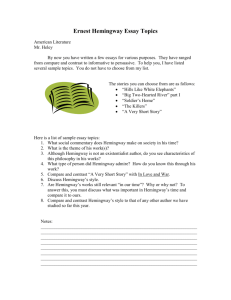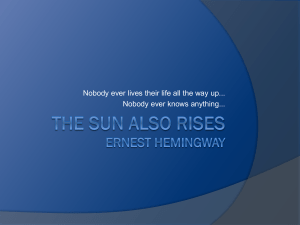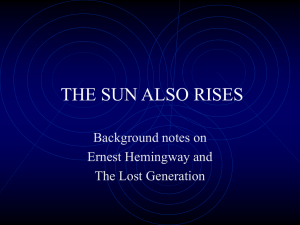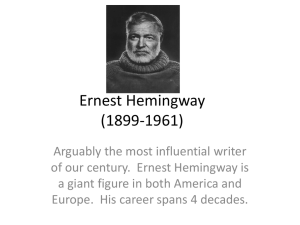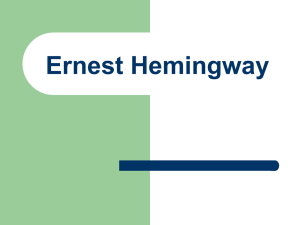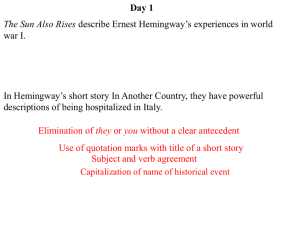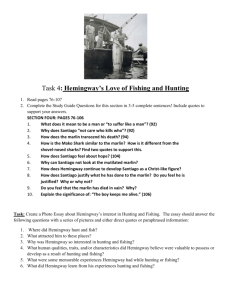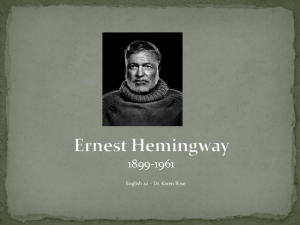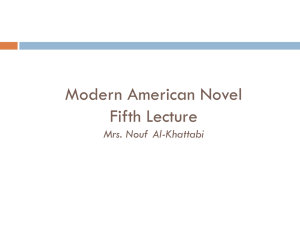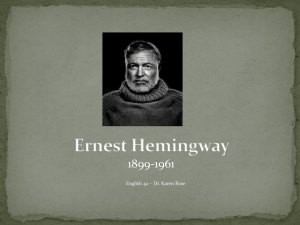1_Hemingway
advertisement
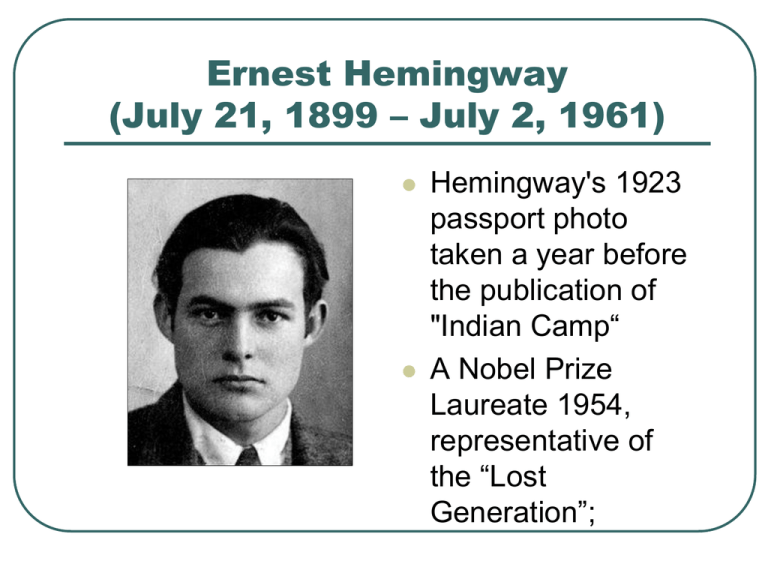
Ernest Hemingway (July 21, 1899 – July 2, 1961) Hemingway's 1923 passport photo taken a year before the publication of "Indian Camp“ A Nobel Prize Laureate 1954, representative of the “Lost Generation”; The "Lost Generation" The "Lost Generation" is a term used to refer to the generation that came of age during World War I. The term was popularized by Ernest Hemingway who used it as one of two contrasting epigraphs for his novel, The Sun Also Rises. In that volume Hemingway credits the phrase to Gertrude Stein (1874 – 1946) who was then his mentor and patron. In our Time (1925) Bildungsroman Bildungsroman is a type of novel concerned with the education, development, and maturing of a young protagonist. http://dictionary.reference.com/browse/bi ldungsroman "Indian Camp" "Indian Camp" is a short story written by Ernest Hemingway. The story was first published in 1924 in Ford Madox Ford's literary magazine transatlantic review in Paris, and republished by Boni & Liveright in 1925 in the American edition of Hemingway's first volume of short stories In Our Time. the Hemingway Canon-- “a fundamental principle or general rule” The story is important because it shows the emergence of Hemingway's understated style and use of counterpoint. "Indian Camp" has themes such as childbirth and fear of death, which permeate much of his subsequent work. When In Our Time was published the quality of writing was noted and praised; scholars consider "Indian Camp" an important story in the Hemingway canon. Iceberg Theory Understated Style The Iceberg Theory (also known as the "theory of omission") is a term used to describe the writing style of American writer Ernest Hemingway. Hemingway is best known for works such as The Sun Also Rises, A Farewell to Arms, and The Old Man and the Sea. only one-eighth of it (iceberg) being above water If a writer of prose knows enough of what he is writing about he may omit things that he knows and the reader, if the writer is writing truly enough, will have a feeling of those things as strongly as though the writer had stated them. The dignity of movement of an ice-berg is due to only one-eighth of it being above water. A writer who omits things because he does not know them only makes hollow places in his writing. —Ernest Hemingway in Death in the Afternoon get the most from the least Hemingway biographer Carlos Baker believed that as a writer of short stories Hemingway learned how to "get the most from the least, how to prune language how to multiply intensities, and how to tell nothing but the truth in a way that allowed for telling more than the truth". Furthermore, Baker explains that in the writing style of the iceberg theory the hard facts float above water, while the supporting structure, complete with symbolism, operates out-of-sight. Criticism of “Indian Camp” Gwendolyn (a female given name: from a Welsh word meaning “white.” ) Tetlow believes that Hemingway's early fiction such as Indian Camp shows his lack of concern for character development by simply placing the character in his or her surroundings. However, in Indian Camp the use of descriptive detail such as a screaming woman, men smoking tobacco, and an infected wound build a sense of veracity (truthfulness). In other words, a story can communicate by subtext; Hemingway's use of counterpoint Hemingway's use of counterpoint in his fiction is evident in "Indian Camp", as at the end Nick trails his hand in the lake water that "felt warm in the sharp chill of the morning". Leitmotif = Guiding Motif A leitmotif (pronounced /ˌlaɪtmoʊˈtiːf/), sometimes written leit-motif, is a musical term (though occasionally used in theatre or literature), referring to a recurring theme, associated with a particular person, place, or idea. It is closely related to the musical idea of idée fixe. The term itself comes from the German Leitmotiv, literally meaning "leading motif", or, perhaps more accurately, "guiding motif." Genre: Initiation Story The story is an initiation story, in which Nick is initiated to the adult world of childbirth and death. Nick's father introduces his son to sexuality, childbirth, and unintentionally to violent death—for Nick the two become inextricably interwoven. Gwendolyn Tetlow maintains that in "Indian Camp" sexuality culminates in "butchery-style" birth and bloody death, and that Nick's anxiety is manifested when he must turn away from the events in the cabin. Initiation Story An initiation story is a fiction in which the protagonist (the most important character in the work) undergoes an experience that is life-changing, and usually that character is a young person who gains a measure of maturity from the experience. Good examples of initiation in short stories are James Joyce's "Araby," John Updike's "A & P," Sarah Orne Jewett's "A White Heron," and Alice Munro's "The Found Boat." In-Class Writing Plot Summary Story vs. Plot: Story vs. Plot: That “The king died and then the queen died” is a story (in which events are chronologically organized) whereas that “The king died and the queen died of grief” is a plot in which the events are linked by causality. E. M. Forster. Aspects of the Novel, 1927. Plot Summary Convention: use the simple present tense; Mention full name (of an author) for the first time and then only use the last name throughout; Condense: the art of selection Michelangelo is said to have created David, a masterpiece of Renaissance sculpture, by taking a block of marble and cutting away everything that was not David. Rewrite No more than five sentences Use the simple present tense and write a brief summary of the story by using Six W’s; Sequence: the chronological order, the climactic/anti-climactic sequence or model it on the Inverted Pyramid, a common method in journalism by which events are organized from most to least important. Fix those problems presented by Wikipedia/Sparknotes! In-Class Writing on Pathology vs. Psychiatry According to Arnold Weinstein, Hemingway has made a distinction between Pathology and Psychiatry. The former refers to a wound or sudden physical injury whereas the latter adds the emotional shock or psychological damage. Psychological traumas are hard to identify from the outside and deepen with time. claim/evidence/warrant/counterargument Pro and Con on Dr. Henry Adams Claim: He is insensitive in such a delicate situation… Evidence: Warrant: Claim: Dr. Adams remains cool at a critical moment. Evidence: Warrant:
